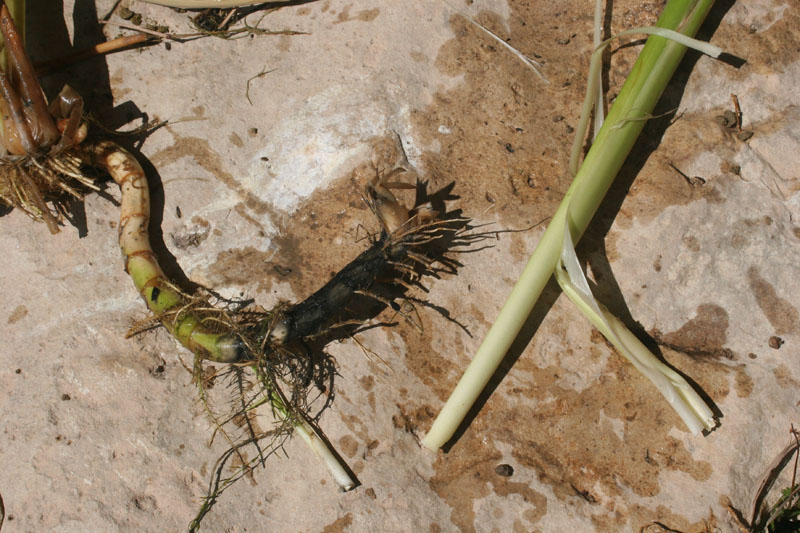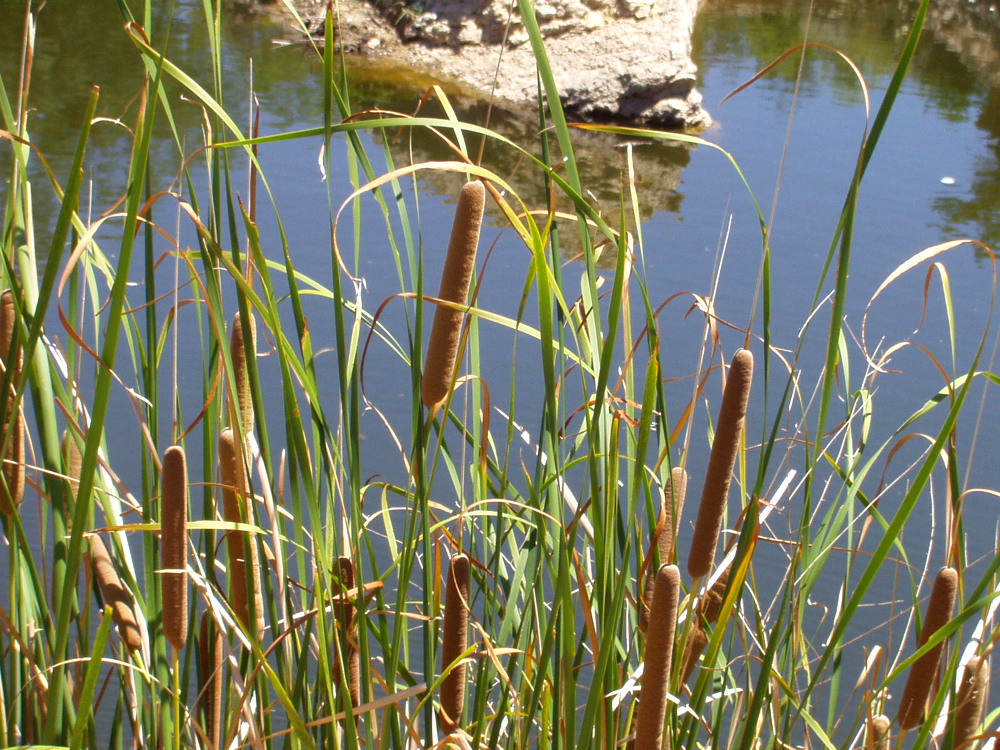Cattail, Tule
Typha domingensis Persoon
Typhaceae (Cattail Family)
A perennial, cattail grows in wetlands, either in standing water or along streamsides and seasonally inundated soils. Based on ethnographic accounts, the plant also is part of many native ceremonies. Indian peoples in both arid and more moist regions utilized virtually every part of the cattail. The roots provided a source of starch; the leaves were woven into containers. Cattails are prolific pollinators, and the flowers and pollen were consumed and utilized for ceremonial purposes.
Cattail's long, flat and narrow leaves emerge from sturdy rootstalks, extending vertically for up to 10 feet. The stem and roots at the base of the plant are white, pithy, and store large quantities of starch, as do the many rhizomes that connect each plant. Hundreds of tiny, unisexual flowers bloom from a long terminal spike that rises to the height of the leaves. In Typha dominguensis, the male and female flowers are separated by a space on the flower stalk. The seed-like fruit, a nutlet or achene, is covered with bristles that form a downy covering.
Archeology. Archeologists have difficulty identifying vegetative plant parts, and as a result few studies identify the plant materials used in basketry recovered from archeological sites in Texas. The one comprehensive study of basketry in the Lower Pecos region, while providing an excellent overview of techniques, does not include identification of the construction material (McGregor 1992). A study of Hinds Cave perishable artifacts lists only species of yucca, agave, beargrass, and sotol as raw materials (Andrews and Adovasio 1981), but this study did not include all of the materials from the shelter.
Cattail has been identified occasionally as construction material in perishable artifacts from the Great Basin (Aikens and Madsden 1986; Madsden 1989). Because it is a prolific pollinator, cattail pollen occurs widely in archeological deposits of rockshelters and in coprolites (desiccated human feces), but it is difficult to determine whether the pollen drifted in, or whether flower stalks were brought into the site, or if flowers were ingested by the human who produced the coprolite. Accidentally ingested (background) cattail pollen appears in most of the coprolites analyzed from the Lower Pecos (Sobolik 1991; Williams-Dean 1978), but at relative percentages below 5%. One coprolite in the Williams-Dean (1978) study registers 11.5%, and this may indicate ingestion of cattail flowers. Considerable evidence for cattail flower storage, manifested in high pollen percentages, was recovered from several rooms in Antelope House, a pueblo in northern Arizona (Bryant and Weir 1986).
Ethnographic records. The widespread ethnographic evidence for cattail use contrasts with the archeological record. This is probably a result of poor preservation of cattail at most archeological sites, and studies of perishable items which emphasized technology or technique over the identification of the materials with which they were constructed.
These helophytes may have been among the root foods sought by Cabeza de Vaca and his cohorts while living among coastal peoples. In his accounts, the Spaniard describes grubbing for plant roots in muddy banks. Plant roots were an important resource, particularly after fish harvests typically diminished in late December. Native peoples of the desert also utilized cattail, including the Western Apache, Pima, Papago, Cahuilla, Maricopa, Mohave, Cocopa, Kamia, Paipai, and many others. The seeds, roots, basal stems, and rhizomes provided a source of starch, the leaves provided material for trays and other types of basketry, and the flowers and pollen had symbolic functions in many rituals.
Food. It is unclear from Cabeza de Vaca's account how coastal people cooked root foods, but techniques likely varied from plant to plant. In other areas, the Western Apache dug the roots and the base of the tule stem out of the water and roasted them for food. Tule flowers were eaten for the pollen, which has a highly concentrated caloric content. The White Mountain Apache and the Northern Tonto ate the white tips of young tule shoots. The Cibecue ate the cattail flower buds raw. The White Mountain, San Carlos, and Cibecue ate the white stem bases as well. During the early 20th century cattail pollen was gathered and put in bottles for sale at the swampy lakes north of Cibecue (Buskirk 1986:193). The Navajo ate the white young stalks and rhizomes raw in the summer (Vestal 1952:14).
Groups living in the Great Basin regularly exploited the cattail resources growing along the lake margins (Fowler 1990; Madsen 1997). The vast lake shorelines of the region provided large quantities of cattail for the Gosiute, Kawaiisu, and others. The Northern Paiute of western Nevada harvested the seeds, grinding them into flour, shaping it into cakes, and roasting the cakes on coals. In the northern areas cattail roots were collected, dried, and stored for the winter months (Fowler 1990). Harvesting cattail roots, stems, and pollen has been demonstrated to be a very cost-effective (in hunter-gatherer terms) means of securing calories (Simms 1987).
The Yuki, Pomo, and Yokia Indians of California utilized cattail roots extensively for food. The roots and the stem bases were harvested and processed in an unspecified manner (Chesnut 1905). The Cahuilla of southern California gathered cattail roots, dried them, and ground them into meal. They also collected the pollen for consumption (Bean and Saubel 1972:143).
Since cattail pollen grains measure between 25-45 microns (about .014 inch) depending on the species, it is legitimate to ask "Why was this a sought after food, and how did the Indians collect and eat it?" First, cattail flowers are very compact and easy to collect, and second, each flowering spike contains hundreds of thousands of pollen grains. Curtin (1984:64-65) provides us with more insight. One of her Pima informants noted that the flowers had to be picked at the right time, presumably when the pollen was mature, but before the flowers opened and ejected the wind-borne pollen. The buds are collected carefully and placed directly into baskets from which the pollen is winnowed into jars. They build a fire to heat and dry out the ground, and then push the ashes aside. Then they add the entire basket or jar of pollen "powder" in layers to carefully build up a flat cake. Water is sprinkled on the top of the cake, and then it is baked by covering it with coals. The finished product is a light brown in color, and has a sugarly flavor the Pima love.
Industry. Havasupai and the Kawaiisu used cattail leaves for thatching roofs and walls of houses (Weber and Seaman 1985; Zigmond 1981). The Northern Paiute used cattail leaves in such diverse applications as construction of shelters, fabrication of sandals and other clothing, and construction of boats (Fowler 1990). The Pima wove the leaves into mats and used the split flower stalks for weaving baskets (Curtin 1984:64-65). The Pawnee, Dakota, and Kawaiisu used the down from the flowers for bedding (Gilmore 1919; Zigmond 1981). The Ramah Navaho used cattail leaves for storage and medicine baskets, bed mats, and coiled mats.
Medicine and ritual. The Mescalero Apache used cattail pollen as a general curative agent (Basehart 1960). The Cahuilla, Omaha, and Pawnee used the root in poultice or powered form as a topical ointment for burns and bleeding wounds (Bean and Saubel 1972; Gilmore 1919). The down from the flowering stalk was used as a powder for chafing (Gilmore 1919).
The Pima used the pollen as decoration for the face, chest, and back (Curtin 1984). Cattail pollen was also used for face paint by the Seri (Felger and Moser 1985:311). The Ramah Navajo used the whole plant as a ceremonial emetic and pollen was used in an unspecified manner, both for the Lightningway ceremony in which they made an interesting connection between cattail and lightning. They made mats and hung them up in the hogan to protect it from lightning; a square mat (male) was hung up on the east side of the hogan, and a round mat (female) on the west side (Vestal 1952:14-15).
References
Aikens, C. Melvin and David B. Madsen
1986 Prehistory of the Eastern Area. In, W. D’Azevedo (ed), Handbook of North American Indians, Volume 11, Great Basin, pp. 149-160.
Andrews, Rhonda L. and James M. Adovasio
1980 Perishable Industries from Hinds Cave, Val Verde County, Texas. Ethnology Monographs No. 5. Department of Anthropology, University of Pittsburgh, Pittsburgh, Pennsylvania.
Basehart, Harry
1960 Mescalero Apache Subsistence Patterns and Socio-Political Organization. The University of New Mexico Mescalero-Chiricahua Land Claims Project Contract Research #290-154, University of New Mexico, Albuquerque, New Mexico.
Bean, Lowell J. and Katherine S. Saubel
1972 Temalpakh: Cahuilla Indian Knowledge and Usage of Plants. Malki Museum Press, Morongo Indian Reservation, Banning, California.
Bryant, Vaughn M., Jr. and G. H. Weir
1986 Pollen Analysis of Floor Sediment Samples: A Guide to Room Use. In Archeological Investigations at Antelope House, ed. by Don. P. Morris, pp. 58- 71. National Park Service, Washington, D. C.
Buskirk, Winfred
1986 The Western Apache: Living with the Land Before 1950. University of Oklahoma Press, Norman, Oklahoma.
Chesnut, Victor King
1902 Plants Used by the Indians of Mendocino County, California. Contributions from the U.S. National Herbarium 7(3): 295-409.
Curtin, Leonora Scott Muse
1984 By the Prophet of the Earth: Ethnobotany of the Pima. Reprint of 1949 book published by San Vicente Foundation, University of Arizona Press, Tucson, Arizona.
Felger, Richard and Mary Moser
1985 People of the Desert and Sea: Ethnobotany of the Seri Indians.
University of Arizona Press, Tucson, Arizona.
Fowler, Catherine S.
1990 Tule Technology: Northern Paiute Uses of Marsh Resources in Western Nevada. Smithsonian Institution Press, Washington, D.C.
Gilmore, Melvin R.
1919 Uses of Plants by the Indians of the Missouri River Region, University of Nebraska Press, Lincoln. [1977 reprint of original, Thirty-third Annual Report of the Bureau of American Ethnology, Smithsonian Institution, Washington, D.C.]
Krieger, Alex
2002 We Came Naked and Barefoot: The Journey of Cabeza de Vaca across North America, edited by Margery Krieger. University of Texas Press, Austin.
McGregor, Roberta
1992 Prehistoric Basketry of the Lower Pecos, Texas. Monographs in World Archaeology 6, Prehistory Press, Madison, Wisconsin.
Madsen, David B.
1989 Exploring the Fremont. Utah Museum of Natural History, University of Utah.
1997 Winter Cattail Collecting Experiments. Utah Archaeology 1997:1-19.
Simms, Steven R.
1987 Behavioral Ecology and Hunter-Gatherer Foraging: An Example from the Great Basin. BAR International Series 381. British Archaeological Reports, Oxford, UK.
Sobolik, Kristin D.
1991 Prehistoric Diet and Subsistence in the Lower Pecos as Reflected in Coprolites from Baker Cave, Val Verde County, Texas. Studies in Archeology 7, Texas Archeological Research Laboratory, University of Texas at Austin. Austin, Texas.
Vestal, Paul
1952 Ethnobotany of the Ramah Navaho. Papers of the Peabody Museum of American Archaeology and Ethnology 40(4). Harvard University, Cambridge, Massachusetts.
Weber, Steven A. and P. David Seaman
1985 Havasupai Habitat: A. F. Whiting's Ethnography of a Traditional Indian Culture. University of Arizona Press, Tucson, Arizona.
Williams-Dean, Glenna
1978 Ethnobotany and Cultural Ecology of Prehistoric Man in Southwest Texas. Anthropology Research Laboratory. Texas A&M University. College Station, Texas.
Zigmond, Maurice L.
1981 Kawaiisu Ethnobotany. University of Utah Press, Salt Lake City, Utah.
![]()


